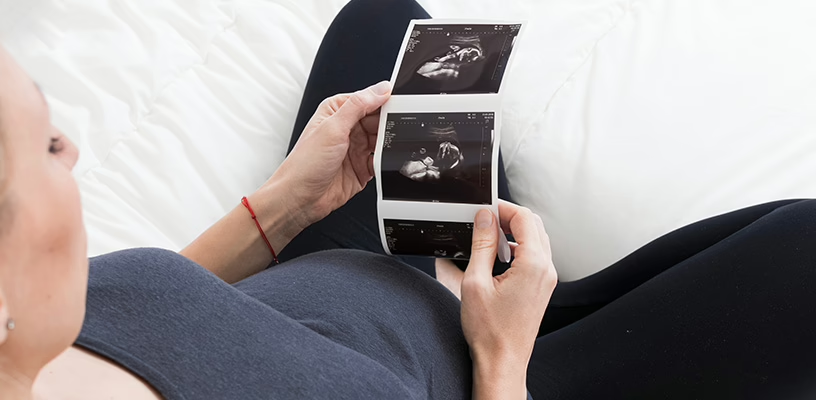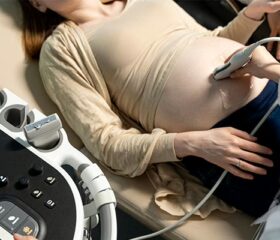Is Nub Theory a Reliable Predictor of Your Baby’s Sex?
Dreaming about whether you’re having a boy or a girl can be fun, but actually discovering it is even more exciting. If you’re desperate to find out sooner rather than later and have taken to searching the web, you may have come across the "nub theory."

Supporters of the nub theory claim you can find out your baby’s biological sex as soon as 12 weeks. Let’s separate fact from fiction and find out if you really can look at your baby’s “nubs” to learn whether you’re carrying a boy or girl a few weeks early.
What is nub theory?
Nub theory centers around the genital tubercle, or “nub”—a small structure that develops in all fetuses prior to 12 weeks gestation. This nub is the precursor to either a penis (in males) or a clitoris (in females) and begins to differentiate as such around the 12-week mark. 1
Nub theorists say that someone with a discerning eye can look at the angle of this nub in relation to the fetal spine on ultrasound and predict a baby’s sex. You may hear this referred to with a cute little rhyme: “the angle of the dangle.”
How does nub theory work?
To even attempt to put nub theory into practice, you’ll need a pregnancy ultrasound. During it, the sonographer (the ultrasound technician) will need to capture a profile image of your baby, showing the entire length of the spine.
From there, the idea is is that you can pay attention to the following signs to see if you’re having a:
- Boy: Imagine a straight line extending across the bottom half of your baby’s spine. If the nub angles upwards toward your baby’s head, nub theory says you’re having a boy.
- Girl: Looking at that same measuring position, if the nub is more aligned with the spine or is pointing down rather than upwards, theorists claim you have a girl.
To see all of that, your baby’s spine needs to be fairly well-developed. If the fetus is lagging a little, it might be hard to make much out at all.
Is the nub theory legit?
So, beyond the hype, how reliable is nub theory, really? Here’s where things get a bit murky.
There’s some truth to the idea that the angle of the dangle corresponds with biological sex—but actually seeing that on an ultrasound is another matter.
Factors like your own body shape and your baby’s position can all influence ultrasound image quality. In practice, it can be difficult to see much on an ultrasound at all. That’s particularly true if you’re just eyeballing the image at home—a trained sonographer or doctor might be able to suss out your baby’s sex at just 12 weeks, but your own odds probably aren’t great. 2
Put another way: nub theory isn’t complete nonsense, but it isn’t a reliable way of predicting whether you’re having a boy or girl. To know for sure, you’ll need to consult with a professional.
What are more reliable ways to determine your baby's sex?
If you’re looking for more scientifically sound methods to find out your baby’s sex, here are some alternatives:
- Non-invasive prenatal testing (NIPT): This screening test analyzes fetal DNA in your blood. It serves primarily to determine the risk of genetic abnormalities, but has the side benefit of identifying your baby’s sex. Your doctor can sample your blood for analysis once you’re 10 weeks into your pregnancy. 3
- Anatomy scan: This is often (incorrectly) called the gender scan, as it’s when most parents first find out their baby’s gender (or, more accurately, biological sex). This is a detailed ultrasound that you’ll get between week 18 and week 22 of your pregnancy, showing your baby’s developmental progress, including the sex organs. 4
- Amniocentesis: This procedure examines your baby for genetic and chromosomal issues, including Down syndrome and cystic fibrosis, by way of testing your amniotic fluid. If you’re at risk of these conditions, you’ll get tested between week 15 and week 20 of your pregnancy, at which time you can also find out your baby’s sex. 5
- Chorionic villus sampling (CVS): Doctors typically do this diagnostic test between week 10 and week 12 of pregnancy to check for chromosomal or genetic issues via the placenta. This kind of analysis can also reveal your baby’s sex. 6
Outside of these tried-and-tested methods, some moms claim that your pregnancy symptoms themselves can be signs of having a boy or a girl (e.g., more intense morning sickness means you’re having a girl).
Others subscribe to the Ramzi theory, which says you’re having a boy if your placenta is on the right side of your uterus and a girl if it’s on the left side.
However, there’s very little scientific evidence that suggests these theories are true, and you probably won’t be able to find out your baby’s sex from your placenta’s location or symptoms alone.
Try out the Chinese gender predictor chart (for fun)
Many moms swear by the Chinese gender predictor chart, which purports that you can determine your baby’s sex based on your lunar age when you conceived and the month of conception. While it’s a fun way to pass the time before you find out your baby’s sex for real, there’s no evidence it works. Still, there’s no harm in trying it out—just don’t take the results too seriously!
Final thoughts
If you’re already eyeballing blue or pink smoke bombs for your gender-reveal party, being in the dark about your baby’s sex can be one of the most patience-testing parts of your pregnancy.
It would be nice if nub theory offered an easy way of speeding things along—but unfortunately, despite the grain of truth to it, there’s a good chance your baby’s anatomy (and the ultrasound image you get) will still be too murky at this early stage. Most of the time, you’ll just have to be patient for a few weeks longer.
Article Sources
- Charlotte Lozier Institute. "Male vs. Female Development" Retrieved April 11, 2025.
- Ultrasound Obstet Gynecol. "First-trimester determination of fetal gender by ultrasound" Retrieved April 11, 2025.
- The University of Texas Southwestern Medical Center. "What noninvasive prenatal testing can (and can’t) tell you about your baby" Retrieved April 11, 2025.
- Penn Medicine Lancaster General Health. "All About the 20-Week Anatomy Scan" Retrieved April 11, 2025.
- March of Dimes. "Amniocentesis" Retrieved April 11, 2025.
- Johns Hopkins Medicine. "Chorionic Villus Sampling (CVS)" Retrieved April 11, 2025.







